SST Global Gathering and Film Screenings
The 8th Global Reggae Conference provided two major opportunities for the project. One was to share our work, with members from the global SST team presenting papers across many of the conference panels. A major feature of this sharing of research results was the entire day of SSO#10 Frames and Frequencies film festival with no less than fifteen SST-commissioned and other films screened (of which more below). The other opportunity was for SST team members from around the world to meet up with each other in person – many for the first time. The SST Global gathering was a hybrid event with fifteen researchers from around the world in the room and six online. For anyone with an interest in sound system technologies and cultures, Jamaica remains the Mecca; so, it is no surprise that they all committed to be part of this conference – many travelling to the island for the first time.
by Siufan Adey and SST Team
The SST Global Gathering
This meeting was designed for sharing the methods, experiences and challenges team members had come across in the course of their work so far. Indeed, there was excitement and joy of being in each other’s company. After everyone had introduced themselves, the discussion was structured round three topics – the annotated bibliography, the sonic map and the case studies as three key project outputs. Rather than reporting on these directly (a transcript of the entire discussion has been circulated to participants), it will be of broader interest to pick out a couple of the common themes that emerged from our global meeting.
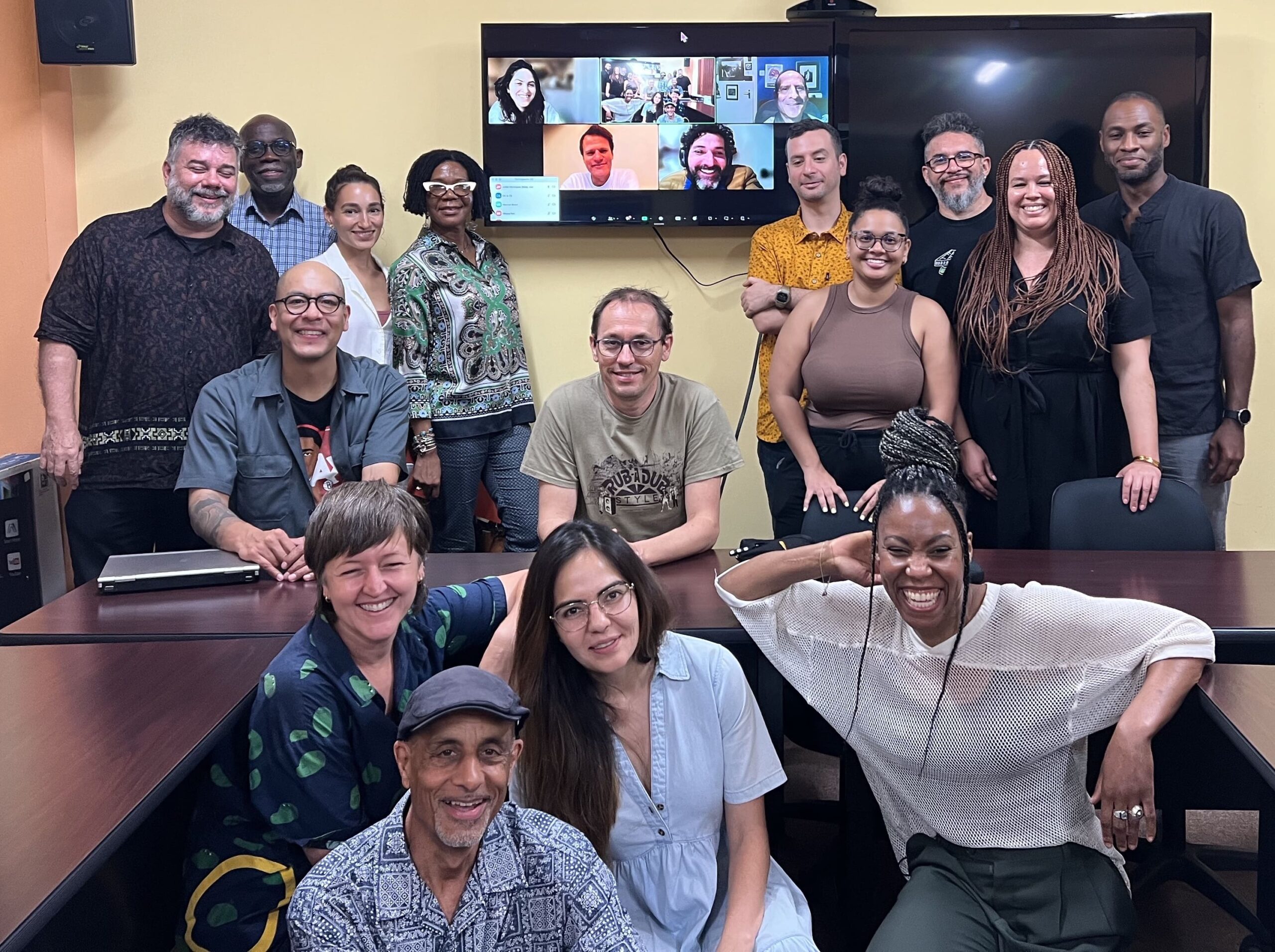
The SST Global Gathering meeting, left to right: Leo Vidigal (Brazil), Dennis Howard (Jamaica), Noelle Jackson (Jamaica), Sonjah Stanly Niaah (Jamaica), Brian D’Aquino (UK), Juan José Carbonell Torres (Brazil), Safia Said (Canada), Mark Campbell (Canada), Ashly Cork (Jamaica); (sitting) César Rebolledo (Brazil), Jean-Christophe Sevin (France), Clare Cooper (Australia), Fernanda Soria Cruz (USA,) Alanna Stuart (Canada), Julian Henriques (UK) and on screen, Paulina Lanz (USA), David Katz (UK), Moses Iten (Australia) and Marcus Ramusyo de Almeida Brasil (Brazil). Photograph: Gionvanni Mugnaini (Italy)
Country Sounds
One theme was the empirical finding that sound system activity is being pushed out of the urban centres into the surrounding countryside. As Leo Vidigal (SST Brazil) reported, this is the case with radiola sound systems in Maranhão outside the state capital of São Luís, in Northern Brazil. In Jamaica, the sound system action is currently outside Kingston, with far more activity in “country,” as Dennis Howard (SST Jamaica) told us. Bass Odyssey, it should be remembered, one of the Jamaica’s preeminent sounds, was a country sound in that the crew hailed from the small community of Alexandria, right in the geographic centre of the island. This dispersal of sound system scenes is caused, no doubt, by increased pressure from the municipal police and the enforcement of noise abatement legislation. The same is happening in Barranquilla and Cartagena, Colombia. These cities have been historically pivotal for the development of picó culture, but street dances are getting increasingly rare.
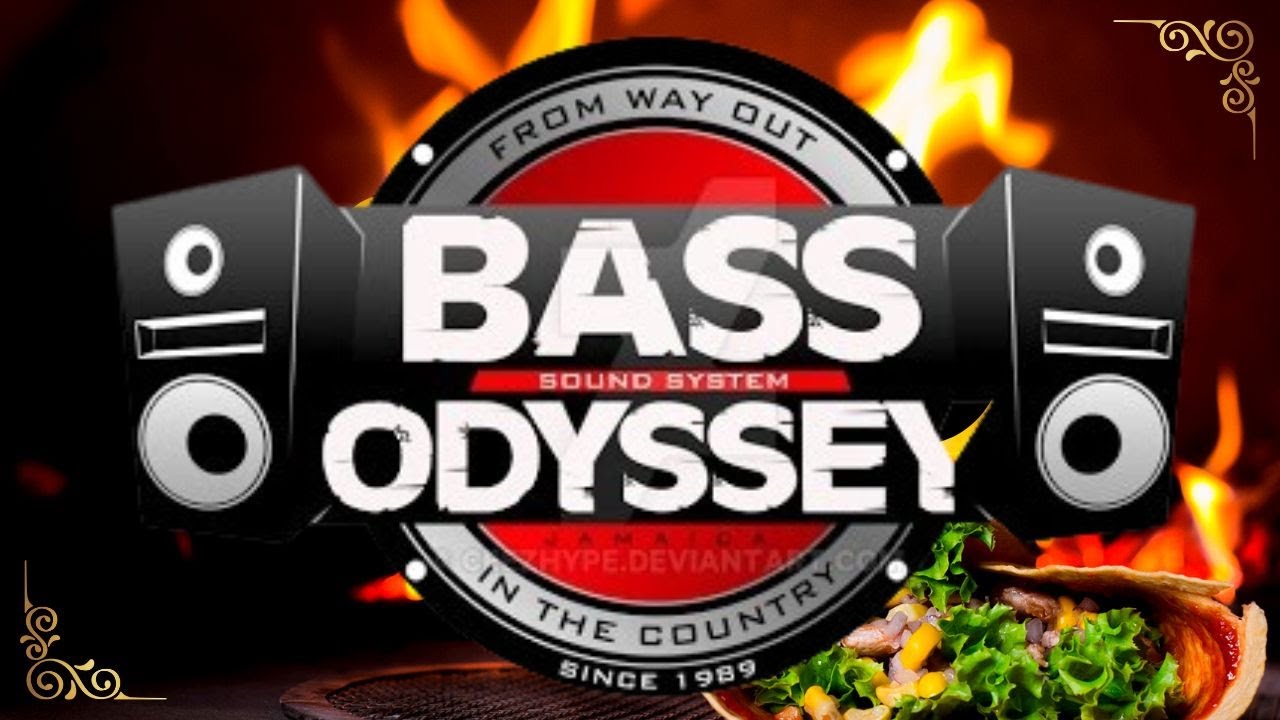
Bass Odessey logo: “from way out in the country”
One typically imaginative response from the street culture and technology to these circumstances has been the rise of truly mobile sound systems, that is those that are built into the body of the car or van. When stationary, the speaker arrays fold out, like Transformer toys and films of the 80s. In Brazil these are called paradoes (walls of sound), see the SST blog. Such highly customised vehicles are also a key part of the sound system scene in the Dominican Republic. The big advantage of the increased mobility of such sound system is that they can literally drive their way away from immanent police restrictions. Several also assemble to form a single long speaker array, linked together by cable or Bluetooth – playing the same track. We have been told that such car sounds are also currently being designed and built in specialist workshops in Kingston (which would make a great blog subject for someone).
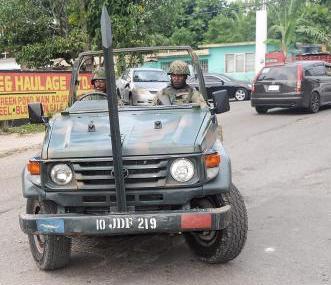
JDR (Jamaica Defence Force) jeep with ram raised, as patrolling dancehall sessions
What makes a sound system?
Another theme for our discussion – central to the SST research project – is simply this: what makes a sound system? This issue came up in our documentary film made from the reasoning session held at JamOne HQ, Kingston Jamaica, in February 2022. There, in the immediate post-Covid period, leading Jamaican sound system owners and operators were bemoaning the fact that currently – and during the pandemic – numerous young people with a laptop and pair of powered speakers were calling themselves a sound system. Though convenient for the smaller scale house parties, for the veterans, this was ”not the real thing.” Nevertheless, the classic reggae sound system of bespoke stack of speaker boxes accommodating a five-way frequency split, is no longer the leading technology in Jamaica – though it is thriving across much of the UK and Europe. On the other hand, the Canada team reported about their country‘s leading reggae sound system King Turbo who, despite a few decades long career, never owned their own set. King Turbo’s ’controversial’ status (according to our own descriptive matrix) raised challenges about the capacity of the research (this research, any research) to fully map street cultures for which elusiveness, fugitiveness and staying off-grid are an organic part of their essence.
So, this raises the question: what is a sound system if not the set of equipment? Sound system selectors, like Tony Matterhorn of Stone Love, Jamaica, have been touring the world, initially with CDs, currently with laptops. It is way more practical and convenient to play on a resident set. This puts the emphasis on the selector’s skills and repertoire, rather the distinctive sounding of the music that each sound system used to have. Is then, a selector him or herself then the sound system? With the sonidero sound system scene in Mexico and California, Fernanda Soria Cruz (SST USA) and César Rebolledo (SST Mexico) told us that it was well-established that a sonidero and sonidera were not considered as such – when they have never built or owned a set of equipment – but were then known as cabinero, with the cabina being the portable set made of a laptop, a stand, a microphone and the peculiar vocal processor. JJ Carbonell (SST Colombia) added that in his country’s pico scene this is known as the maleta (literally ‘bag’ or ‘luggage’, containing the control tower).
Indeed, the choice of a new generation of female-owned sound systems (Honey Trap in Australia, Roots Daughters in Germany) for small and portable sets, or for not owning a set at all (Feminine Hi Fi in Brazil), might suggest that the emphasis on the size and power of the kit – number of bass boxes etc – only reflects the macho attitude at the core of sound system cultures as traditionally male-dominated spaces, as noted by Brian D’Aquino during the discussion following their films. Indeed, the music collection has a huge importance in building a sound system’s profile and status, especially when it comes to the exclusive or rare tunes. But, if it isn’t the equipment, how to situate sonic street technologies and sound systems as unique techno-cultural assemblages distinct from DJ cultures (with whom they usually interact with?)
Virtual Sounds
These questions go to the heart of the SST project as they embody the ever-changing relationship between culture and technology. The actual research finding, as above, is a stimulus to think about technology in a different way – indeed, the aim of the project. If a sound system is no longer speaker boxes, amplifiers and crew, maybe it could be considered as a virtual technology? It is virtual not as with VR, but in the sense of a streaming service that provides music without specialist equipment, or laptop music production software that only emulates actual musical instruments. Indeed, all phonographic reproduction is virtual in the sense that it is not a live performance.
Perhaps then, a sound system should be described in terms of the quality of its sounding, or the nature its session, or its historical association with a traditional sound system, or simply its self-identification as such. This may make the investigation more complicated, but its more accurate to what’s going on within actual SST scenes. This is what happens when you liberate technology from its conventional box, and one of my own (Julian Henriques) take-aways from the meeting – but fellow SST team members will no doubt have many others.
Frames and Frequencies
SSO#10 Frames and Frequencies: Films on Sound System Cultures Worldwide, was curated and produced by me Siufan Adey, as the SST video archivist. It was a day-long online and in-person film festival held on the Thursday of the Global Reggae Conference.
From the SST conference programme message:
The contribution to the 8th Global Reggae Conference that SST would like to make is to truly outernationalise it. As with all previous GRC editions, this one has attracted reggae scholarship from around the world. With this one, SST aims especially to place Jamaica’s reggae sound system in a global context – with conference presentations on their spread around the world – Europe, Australia, UK, Canada, South Africa and India. Another SST contribution is to show how Jamaica’s pioneering street technology manifests itself in different versions – with similar but different sound systems, playing local music – in Mexico, Colombia and Brazil.
We screened a collection of 15 remarkable documentaries on various sound systems around the world, with representation from every continent bar Antarctica. The geographical spread of the films was matched by the diversity of sound system technologies and cultural practices portrayed – from Jamaican reggae sound systems and their outernational diaspora in India, the UK, South Africa and Australia, to Colombian picós, Amazonian aparelhagens, Brazilian radiolas, and customised sound system van culture imported to the USA from the Dominican Republic. More information about the individual films can be found here.
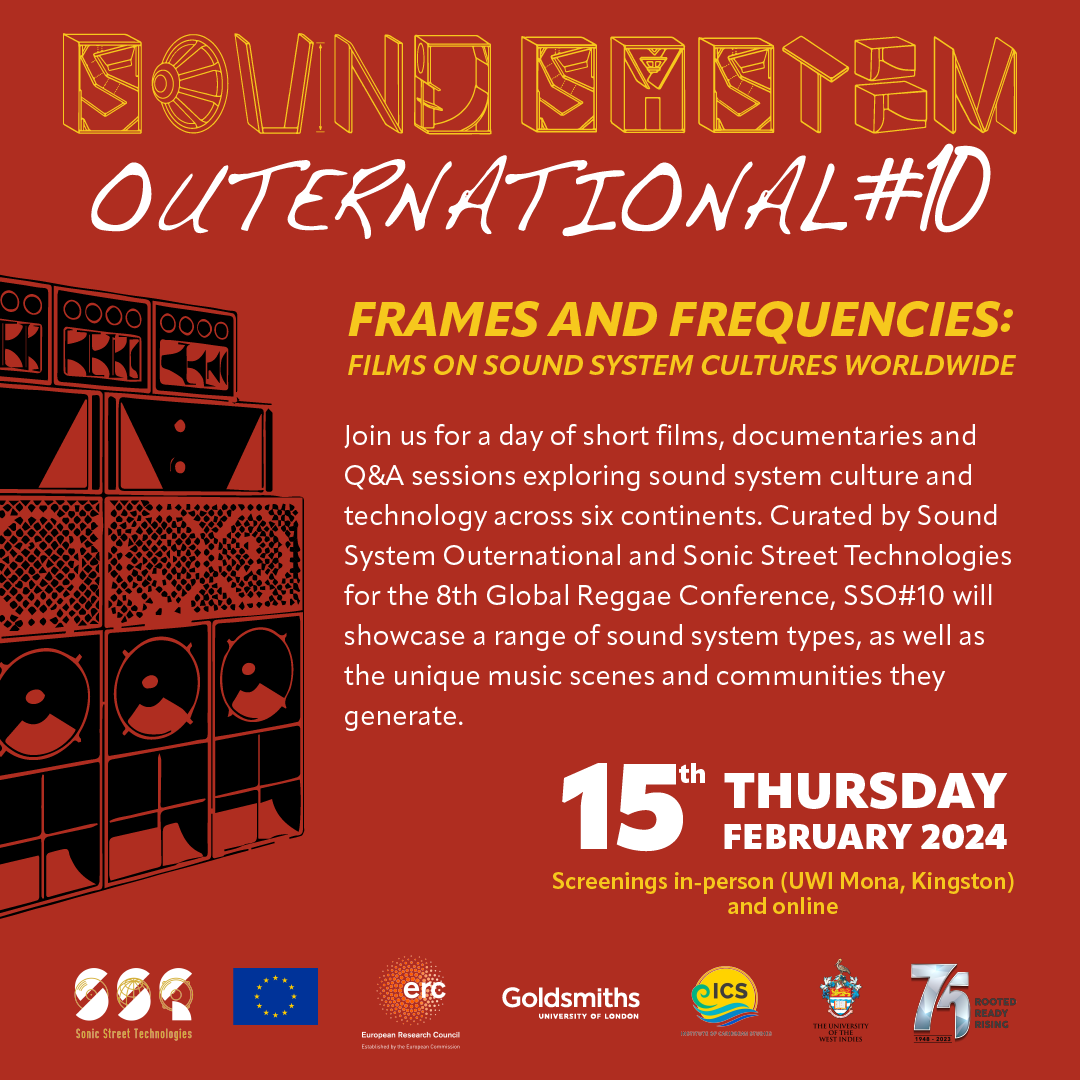
Astarbene’s flyer for SSO#10 Frames and Frequencies
In alignment with our non-extractive research methodology, it was of the utmost importance for us to share the films with the sound systems and communities featured in them – even if they have the means to fly out to the conference or not. Additionally, we wanted to broaden access to the event to those unable to make it in person, thereby sharing these brilliant films with as many people as possible. The solution, following extensive testing and refining in partnership with the GRC team, was a hybrid in-person and online setup. This required no less than four Zoom accounts, six computers (four in London, two in Kingston), one camera, one switchboard, three hard drives, two roaming microphones, one auditorium in Kingston, one conference room in London, and one highly active Whatsapp group chat between the two SST members in London (Siufan and Yael) and Julian and Brian, who were in the auditorium in Kingston.
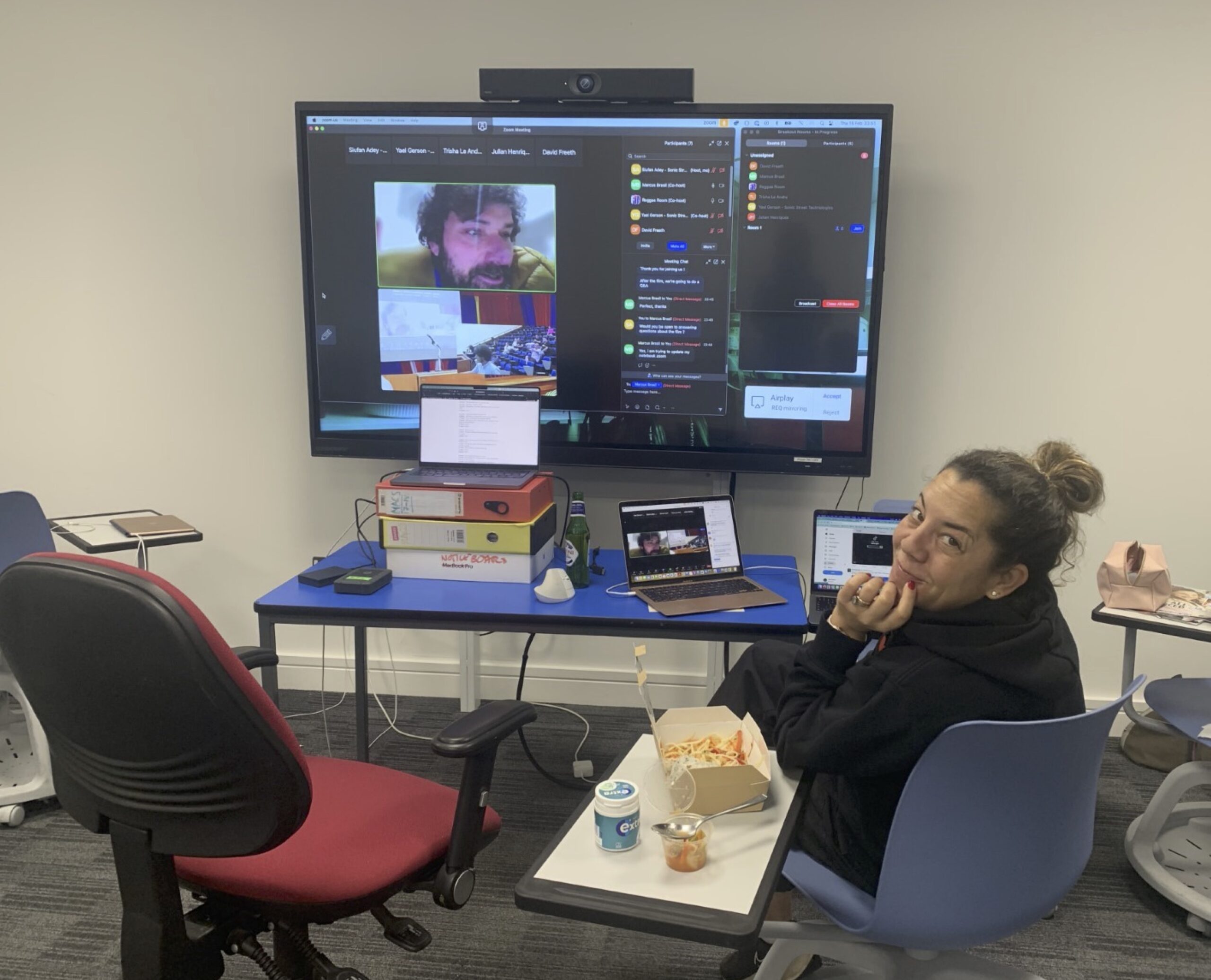
Yael Gerson (SST Research Manager) in the control room at Goldsmiths around midnight. Photograph: Siufan Adey
It was a complex technical setup and a truly global operation, but the film festival’s seamless execution was testament to the careful planning and strong collaboration that preceded it. We want to express our gratitude to the GRC team: Dr Sonjah Stanley Niaah, Bettene Ross-Lawes, Kaydiann Williams, Ashly Cork, Dennis Howard, Suchetta Stephenson and Peter Watson. And a special thank you to Briant Fletcher, who was technician on the day.
This hybrid format not only allowed the Kingston and virtual audiences to watch the films concurrently, but also enabled five virtual Q&A sessions to take place throughout the day. Across these Q&A sessions, 19 guest speakers (including sound system practitioners, directors, producers and family members) participated in interactive, three-way conversations with both the virtual and in-person audiences.
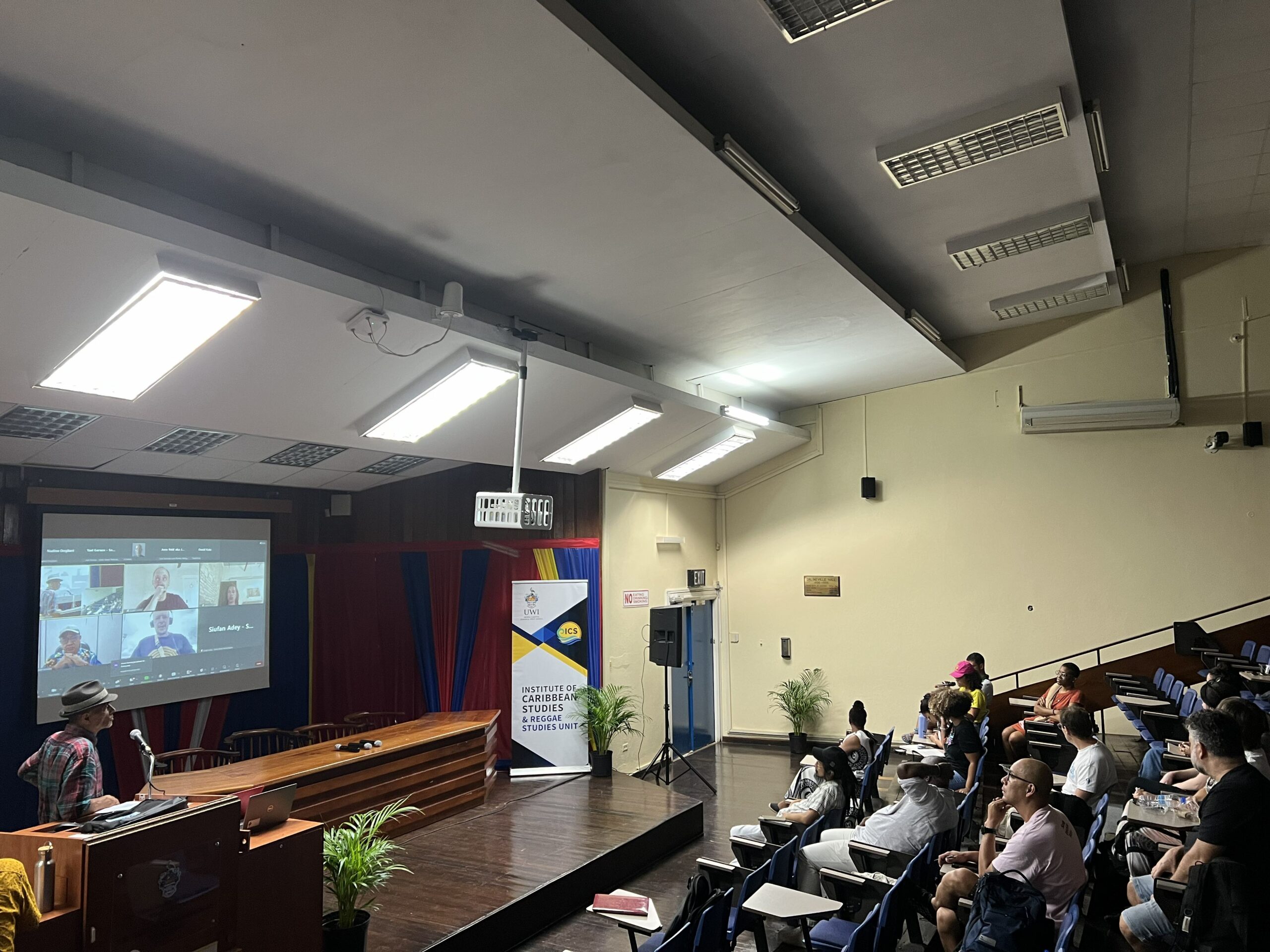
Filmmakers online for the Q & A. Photograph: Giovanni Mugnaini
Our thanks to Lekentle Mohlala (Kebra Ethiopia), Roy Dipankar and Bala Subramaniam Swayampakula (Monkey Sound System), Mikael ‘Ninjah’ Heli and Petah Sunday (10,000 Lions), Taru Dalmia (BFR), Junior Almeida, Darien Lamen, Sean Frank, Ricardo Vega (El Gran Latido), Miladis Córdoba Rivas, Willinton Albornoz Quejada and Jhon Rafael Paz Perea (Urabà Sound System Collective), Laylah Arruda (Feminine Hi-Fi), Maia dal Berger (Honey Trap), Moses Iten and Francesco Vicenzi, Adrian Hough (Adrian’s Wall) and Marcus Ramusyo de Almeida Brasil for their insightful contributions.
These Q&As were a significant moment for many of our guest speakers. It was a chance to share their work with, and pay tribute to, Jamaica – the birthplace of reggae and a source of inspiration for their own sounds. But it was also an ice breaker between some of the practitioners on the Zoom call, who had previously heard of one another through festivals and social media but had not yet met due to physical distance.
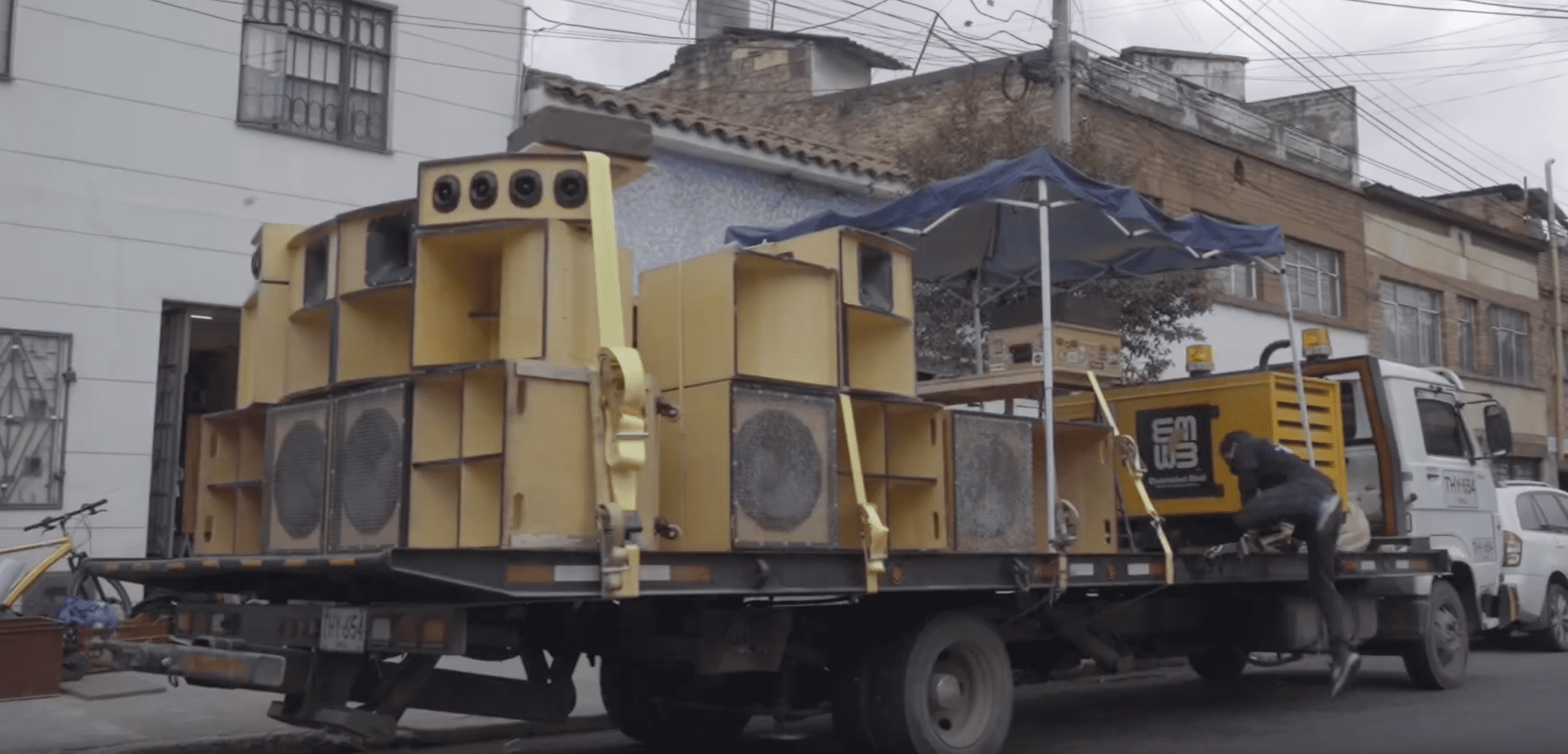
Screen grab from El Gran Latido’s (Colombia) short film
Ahead of the conference, we shared the films among our guest speakers so they could watch each other’s films before their Q&A sessions. Maya Gold, owner of Sydney’s Honey Trap sound system, even booked a lecture theatre and organised a screening with her community. Due to the time difference between Australia and Jamaica, Sydney’s sound system community would have otherwise missed out on most of the film festival.
The sharing of work and long overdue gathering of our guest speakers infused the Q&As a very special energy. Witnessing the exchange of love and respect among the filmmakers and sound system creators was a huge privilege. It underscored the value of the film festival, and by extension the SST project, in fostering connections within the global sound system community.
In addition to the technical considerations, meticulous scheduling was required to accommodate participants in different time zones. The program began at 10am Jamaica time with the premiere of a work-in-progress by Kebra Ethiopia, a South Africa based sound system (that arrived only hours before the screening), followed by screenings of three films from India. Screenings in the early afternoon included works from the UK, USA, Brazil and Colombia, while the late afternoon featured shorts from Australia. The event concluded in the evening with two films made in Jamaica. This resulted in a notable wave-like phenomenon in our audience, as viewers from India and Europe went to bed and those from Australia, New Zealand and west coast USA began to rise and joined the Zoom call. Thanks to these time zone provisions, the event was able to attract over 200 audience members from around the world throughout the day.
Upon reflection, SSO#10 was an incredibly ambitious undertaking but one that we can proudly say was a first in sound system, film and conference history. Never has there been such a large gathering of filmmakers and sound system practitioners from so many places around the world in a hybrid virtual and in-person format. We hope that the future instalments of Frames and Frequencies will include more representation from the Southwest Asia and North Africa (SWANA) region, Sub-Saharan Africa, East and Southeast Asia (ESEA) region, Polynesia, and maybe even a sound system from Antarctica!
Siufan Adey is a researcher and video-maker, currently video archivist for the SST project. She is also co-founder of Afterparti, a collective that produces a zine and event series to platform underrepresented voices in the built environment.
